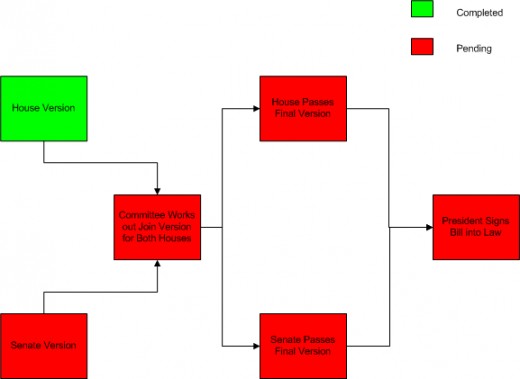Problems with the Health Care Reform Bill(s)
As the Bill Trundles through Congress
The House version of the Bill passed on Saturday, November 7, 2009. It is currently moving through the Senate. Just last week the Senate passed a resolution to open the bill to debate.

Senate Version in the Works
The biggest issues so far with the Senate version are the illegal immigrant restrictions (they will not be covered), increased taxes, whether or not to allow abortion, and whether or not to support a public option1.
Public Option The Biggest Obstacle
With such a narrow majority in the Senate every Democrat and Independent would have to vote for a bill that includes a public option. However, two independents including Joe Lieberman, have promised to join a Republican filibuster should a public option be included. Lieberman voted to allow debate on the bill, but made it quite clear that should the bill include such an option he will move to block the bill, siding with the Republicans in a filibuster.
Lieberman's stated objection is that the public option represents a "radical departure" from past government oversight of business. Such oversight typically involves targeted legislation and litigation; not an all encompassing bill.
1 Meaning a government run insurance plan.
Final Version Must be Approved by both Houses
As with all congressional law both the House and the Senate must come up with a bill both can vote yes on.
For that reason House passage is just one of four steps that must be completed before the bill becomes law. The Senate must pass a version. Then both the House and the Senate must combined and vote yes on a final version. Finally, the president must sign the bill for it to become law.
Problems with the Bill
Regardless of what version is finally passed certain provisions are likely to remain unchanged. Here's the list and the impact each provision will have on coverage.
Pre-existing Conditions
This is all well and good, but how many know that the provision itself will not actually take effect until sometime in 2013 in the House Bill or 2014 in the Senate version? Reigning in the insurance companies will not happen overnight.
The stated reason is to give insurance companies time to comply with the new provisions. But what's not stated, but quite obvious, is that this delay will also reduce the cost of the bill to the Federal Government. This is to be expected, in a way, since costs have been a major sticking point in both houses.
The net result, however, will be no guarantee that the currently denied will be able to get coverage anytime before 2013.
Coverage
Under the Senate version of the bill 94% of Americans (under the age of 65) would be covered; the House version covers 96%. This means that anywhere between 12% and 16% of Americans (does not include illegal immigrants who are not covered), will remain uninsured. Both bills will require Americans to buy coverage or face fines. The fines would be rolled into a federal pool of funds designed to help cover Americans below a certain income threshold.
Affordability
Many Americans are expected to stay with their employer sponsored plans. Those Americans who are self-employed will be able to buy insurance through a marketplace pool set up for that purpose. Some of those self-employed are expected to be subsidized by the government.
Lower income types will have substantial aid from the government, but those subsidies drop off drastically for middle-class Americans.
For example a family of four making up to $44,000 per year would expect to pay roughly $200 per month for coverage. A similar family of four making up to $66,000 per year would expect to pay $550 per month. That's quite a difference.
Younger Americans, who typically do not have many health problems, would also be expected to buy insurance or face fines. However, a provision in the bill will make it possible for young Americans under the age of twenty-seven (27) to remain on their parent's plan. However, this particular provision will not take effect until 2010.
Regardless the age differential will be substantially reduced. e.g. the insurance companies habit of charging younger Americans less will have to change in order for affordable coverage to be offered to older Americans. The net effect, of course, will be that younger Americans will see their premiums rise.
To offset this potential problem the Obama Administration has asked for a five billion dollar temporary risk pool. Unfortunately the Congressional Budget Office predicts this pool will be tapped out by 2011.
Cuts in Medicare
Cuts in Medicare payments to hospitals and other providers are expected to help defray the cost of insuring currently uninsured Americans. So yes, there will be cuts. Even so current Medicare benefits are not expected to be reduced. However, those who signed up for Medicare Advantage could see a reduction in extra benefits. These "extras" include lowered co-pays and lowered deductibles.
Prescription Drugs
Both bills offer cheaper prescription drugs.








